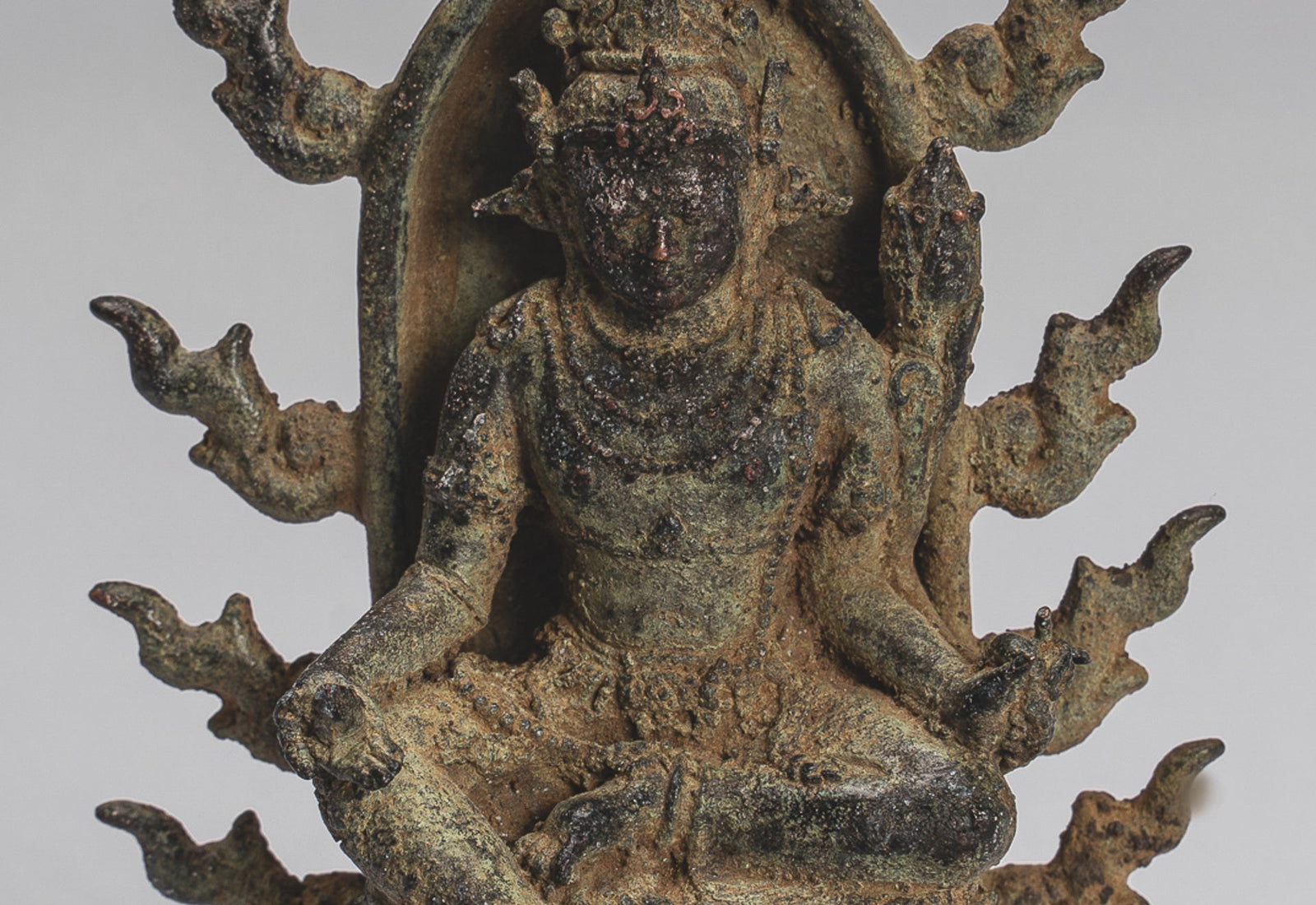
Tara in Majapahit Indonesia: The Divine Mother of Wisdom and Compassion
During the golden age of the Majapahit Empire (circa 1293–1527 CE), Indonesia stood as a vibrant center of Hindu-Buddhist philosophy, maritime power, and artistic brilliance. Amidst its pantheon of deities and bodhisattvas, one figure emerged with quiet yet profound importance—Tara, the female bodhisattva of compassion, protection, and wisdom.
Venerated as both a goddess and savior, Tara held a special place in the spiritual landscape of East Java. Her presence in temple art, royal devotion, and tantric practice reveals a sophisticated synthesis of Indian Mahayana and Vajrayana Buddhism, adapted to the local Javanese context.
Tara was not only a religious figure—she was a symbol of divine femininity, political legitimacy, and esoteric power.
🛕 Historical Context: Buddhism in the Majapahit Empire
The Majapahit Empire, based in East Java, was a Hindu-Buddhist polity that followed the decline of Srivijaya and Singhasari. Its rulers embraced syncretism, blending Shaivism, Mahayana, and Tantric Buddhism into a uniquely Javanese worldview.
-
King Kertanegara of Singhasari, a predecessor to Majapahit, was a major proponent of tantric Buddhism.
-
His legacy continued in the royal court of Majapahit, where deities like Tara were invoked as part of royal rituals, spiritual protection, and state ideology.
This period also saw the flourishing of candi (temple) architecture, where Tara and other bodhisattvas were immortalized in finely carved reliefs and statuary.
🌺 Who is Tara?
Tara is a central figure in Mahayana and Vajrayana Buddhism, often regarded as the female counterpart to Avalokiteshvara (Lokeshvara), the bodhisattva of compassion. In Sanskrit, "Tara" means “Star” or “She Who Ferries Across”, symbolizing her role in guiding beings across the ocean of samsara (worldly suffering).
There are many forms of Tara, but the two most prominent are:
-
Green Tara: The active, swift protector and remover of obstacles.
-
White Tara: The compassionate mother, associated with healing and longevity.
In Java, she was often identified with Wisdom Tara, associated with prajñā (insight) and tantric rituals.
🔱 Tara as Royal Protector and Divine Consort
During the Majapahit era, Tara was often invoked in tantric court rituals, where she served as:
-
A source of spiritual power for kings (rajasiddhi)
-
A consort in esoteric union with male deities or bodhisattvas
-
A protector of the realm and its ruler
Majapahit kings were sometimes viewed as Bodhisattva-kings who ruled with divine support. The feminine energy of Tara helped balance and empower royal authority, often in tandem with male bodhisattvas such as Manjushri or Vajrapani.
It is also likely that some queens and royal consorts were ritually associated with Tara in tantric consecration ceremonies, elevating their roles as spiritual as well as political figures.
🧘♀️ Tara and Tantric Buddhism in East Java
The Buddhism practiced in Majapahit was deeply tantric—influenced by Vajrayana teachings that emphasized rituals, mantras, and deity yoga.
In this context, Tara was more than a passive figure of mercy. She was a dynamic force, invoked for:
-
Protection from danger or war
-
Guidance in meditation
-
Esoteric empowerment (abhiseka) for advanced practitioners
-
Mystical union in visualization practices
Tara was often considered a śakti, or spiritual energy, inseparable from the awakened mind itself.
🪔 Temples and Sculptures Dedicated to Tara
While there is no single temple known solely as a “Tara temple,” she appears frequently in reliefs and statuary in the temples of East Java.
Notable examples include:
1. Candi Jago (Tumpang)
-
Originally a Buddhist temple, it contains images of Manjushri and possibly Tara.
-
Built during the Singhasari period but continued to be revered during Majapahit.
2. Candi Surawana and Candi Tegowangi
-
These temples house rich tantric iconography, including bodhisattvas with consort forms, which may reference Tara or her tantric aspects.
3. Sculptures and Inscriptions
-
Stone and bronze sculptures of Tara from the Majapahit period show her in tribhanga posture, often holding lotus flowers, with a serene, meditative expression.
-
Some wear elaborate jewelry and high crowns, reflecting their divine and royal association.
🎨 Iconography of Tara in Majapahit Art
Tara’s depictions during the Majapahit period draw from both Indian prototypes and local Javanese artistry.
Key features include:
-
Lotus flower: Symbol of purity and spiritual unfolding.
-
Varada and abhaya mudras: Gestures of compassion and protection.
-
Third eye or urna: Denoting spiritual insight.
-
Graceful, slim form: Echoing local aesthetic preferences.
-
Elaborate jewelry and crowns: Reflecting royal elegance and divine majesty.
Some representations may have four or more arms, depending on the tantric tradition being referenced.
🌏 Cultural Synthesis and Local Adaptation
Tara in Majapahit Indonesia was not worshipped in isolation, but as part of a rich spiritual matrix that included:
-
Hindu deities like Shiva, Durga, and Vishnu
-
Bodhisattvas like Avalokiteshvara, Manjushri, and Vajrapani
-
Local animist spirits and ancestor reverence
This created a uniquely Javanese syncretism, where Tara could be seen as:
-
A bodhisattva,
-
A goddess, and
-
A queenly figure of mystical power, all at once.
🕊️ Legacy and Influence
The fall of the Majapahit Empire in the early 16th century and the rise of Islam led to the decline of Buddhist state worship. However, the legacy of Tara and tantric Buddhism survived in subtle forms:
-
In Balinese Hinduism, where deified ancestors and female deities echo Tara’s qualities.
-
In modern Indonesian art, where Tara remains a muse for painters and sculptors.
-
Through preserved temple ruins, statuary, and inscriptions, which continue to inspire scholars and practitioners alike.
✨ Conclusion: Tara as the Majestic Mother of Enlightened Wisdom
In Majapahit Indonesia, Tara was far more than a remote bodhisattva—she was a living presence, invoked in ritual, honored in sculpture, and woven into the very fabric of sacred kingship. She embodied compassion and insight, but also sovereignty, protection, and the esoteric power that guided both spiritual seekers and political rulers.
Her influence in the Majapahit period reminds us that divine femininity was not only revered but also integral to the spiritual and cultural foundations of one of Southeast Asia’s greatest empires.
🛕 Explore Sacred Feminine Icons
At HDAsianArt.com, we honor the divine feminine with a curated collection of authentic and inspired Tara sculptures, including rare Southeast Asian representations.
Explore our offerings to reconnect with the timeless wisdom and serenity of this radiant bodhisattva.


